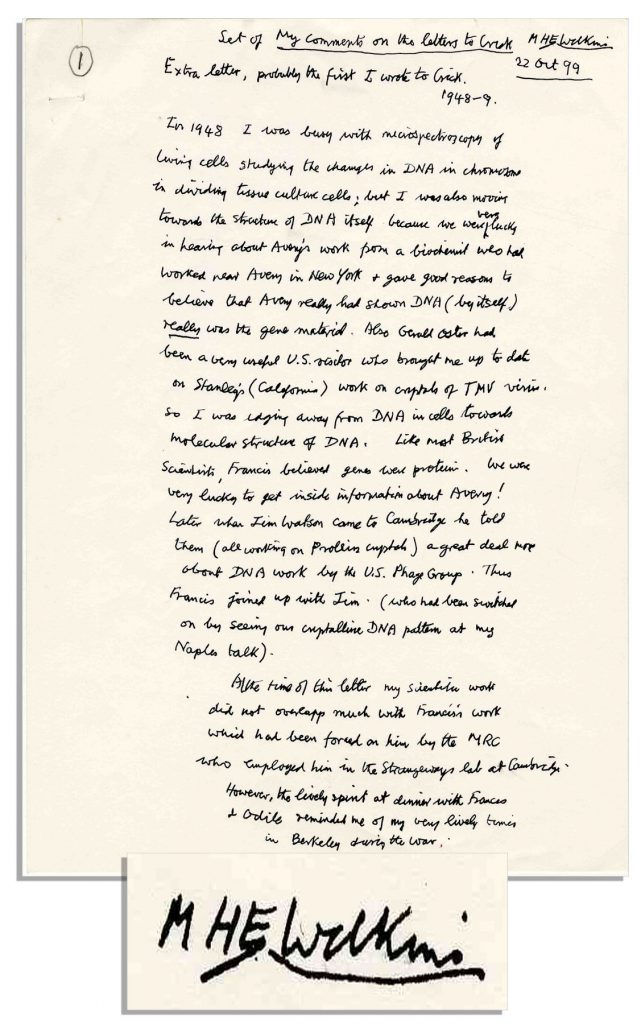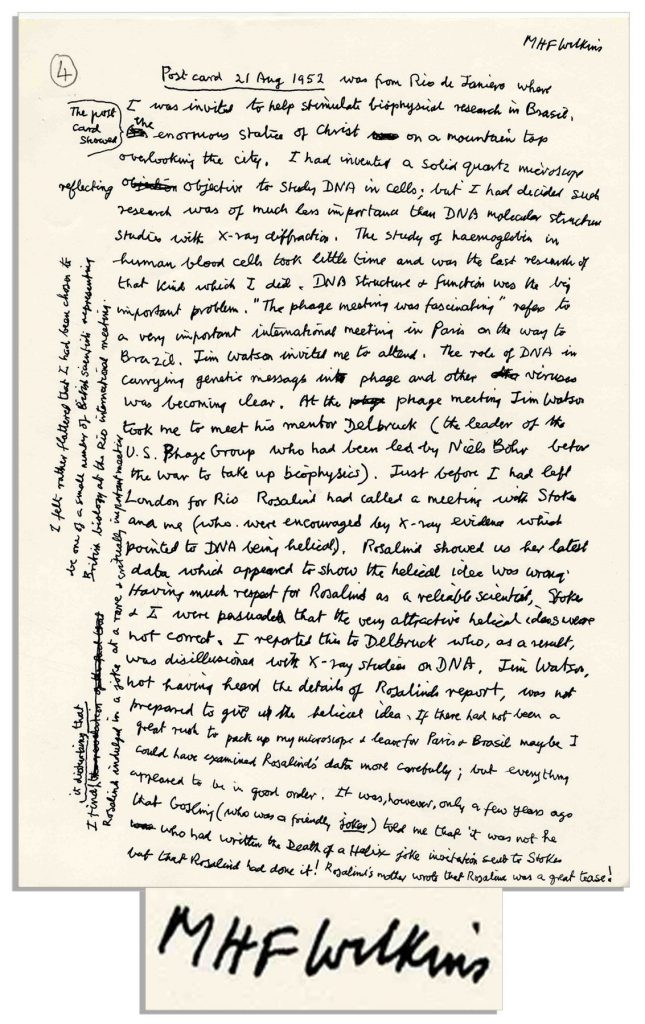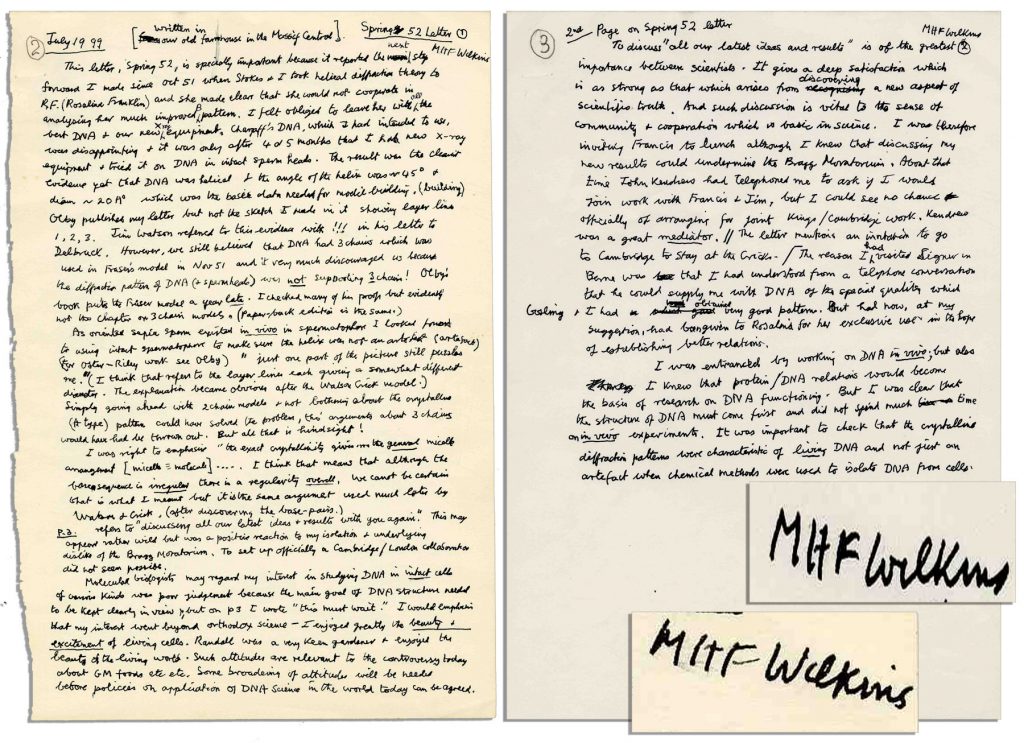Sell Your Maurice Wilkins Autograph for up to $5,000 or More at Nate D. Sanders
FREE VALUATION. To buy, auction, sell or consign your Maurice Wilkins autograph that is for sale, please email [email protected] or call the Nate D. Sanders Auction House (http://www.NateDSanders.com) office at (310) 440-2982.
Please let us know if you have a Maurice Wilkins autograph for sale. Top dollar obtained for your Maurice Wilkins autograph.
Maurice Wilkins Autograph Sold
We have sold many items at auction with a Maurice Wilkins autograph. Maurice Wilkins made several scientific contributions, but is perhaps best known for his work with Rosalind Franklin, Francis Crick and James Watson to uncover the structure and base pairs of DNA. Wilkins, Crick and Watson were awarded the Nobel Prize in 1962. Please see lot details for Maurice Wilkins autograph items below.
Maurice Wilkins Autograph Manuscript Signed — With Early Ideas of DNA’s Structure Mentioned — “…what is Life!?…Francis had a simple-minded anti God attitude which certainly did not link with my rather extreme philosophical interests…”
Maurice Wilkins manuscript signed, dated 23 February 1999. Manuscript, on one page, discusses a 1948 letter Wilkins had written to Francis Crick as their relationship was burgeoning, both as scientists and friends, and as their preliminary ideas of DNA’s true structure were beginning to be investigated. Photocopy of the original letter is included, which has small notes in the margins, presumably in Wilkins’ hand, annotating some of the information he originally wrote. Manuscript discusses Wilkins and Crick’s personal lives, including mention of Crick’s relationship with his soon-to-be wife, Odile Crick, an artist whose sketch of the double helix was published alongside the famed Watson & Crick article in “Nature” magazine announcing their discovery of DNA’s true form. Manuscript further discusses Wilkins’ and Crick’s differences in character, particularly of their conflicting views on religion. Reads in full: “Notes on letter 3 II 48 / one of the few letters properly dated / Looking back it seems I did little to look to the future and thought the day of the week was enough! I certainly knew that DNA & gene structure was central in biol. & that was why I chose it but I did not foresee how highly focused attention would become on the Double Helix itself. Both Crick & I had had [sic] been led into the area by Schrodinger’s book with its title which had more challenge in it than I saw properly & which is a point still missed by most scientists. What is Life!? I should stress that more in my autobiography! I was still living at my married sister’s house. I suppose I had enough kitchen access to entertain friends to dinner. Francis (as he soon became –> my dear Francis) got me a v flat in Tottenham Ct Rd when his friends were moving to S Africa. After a fairly intense year with a very interesting painter I was now alone & very keen to contact attractive women with the long-term intent of marriage & children (after my U.S. divorce). Odile was involved in fine arts (& fashion I think & I much valued her cultural interest to broaden Francis’s very energetic scientific discussions. Both of them produced a very lively — even hilarious spirit which contrasted with my usually intense(?) [sic] serious interest in existential ideas of Kierkegaard & Simone Weil. I will go much into that in my autobiography which might confuse more readers but K’s [Kierkegaard] idea that religious ‘belief’ should not be regarded as something which might make life more comfortable suited me well. How I got onto those written I do not know. I hardly ever have met anyone with those strange ‘pessimistic’ ideas. Francis had a simple-minded anti God attitude which certainly did not link with my rather extreme philosophical interests. I liked Simone’s ‘there are no scientists anymore, only technicians’ (rough quote) but Francis was not a person to discuss such subtleties. I liked him because he was warm and friendly — human as well as very bright scientifically. I was glad he married Odile fairly soon; they had a warm friendly home; very lively & jolly, a pleasant contrast with my philosophical gloom! Searching for meaning in life…” Signed boldly in full “Maurice Wilkins”. Manuscript measures 8.25″ x 11.5″ with staple holes at top right, else fine condition. Sold for $5,000.
Maurice Wilkins Autograph Manuscript Signed Regarding DNA — “…I was edging away from DNA in cells towards molecular structure of DNA…Francis [Crick] believed genes were protein…”
Superb Maurice Wilkins autograph manuscript signed, dated 22 October 1999. Comprehensive manuscript on one page discusses a November 1948-9 letter Wilkins had written to Francis Crick as their relationship was blossoming and their preliminary ideas of DNA’s true structure were still being explored. Photocopy of the original letter is included which also bears his signature, “MHF Wilkins” and additionally, a small annotation in his hand: “Set of letters to Crick (showing my notes in red)”. Manuscript is written in black ink with a bold “MHF Wilkins” signed at the upper right corner. Reads in full: “Set of My Comment on the Letters to Crick / 22 Oct. 99 / Extra letter, probably the first I wrote to Crick. 1948-9 / In 1948 I was busy with microspectroscopy of living cells studying the changes in DNA in chromosome in dividing tissue culture cells; but I was also moving towards the structure of DNA itself because we were very lucky in hearing about [Oswald] Avery’s [who discovered that DNA is the material of which genes and chromosomes are made] work from a biochemist who had worked near Avery in New York & gave good reasons to believe that Avery really had shown DNA (by itself) really was the gene material. Also Gerald Oster had been a very useful U.S. visitor who brought me up to date on Stanley’s (California) work on crystals of TMV virus. So I was edging away from DNA in cells towards molecular structure of DNA. Like most British scientists, Francis believed genes were protein. We were very lucky to get inside information about Avery! Later when Jim Watson came to Cambridge he told them (all working on protein crystals) a great deal more about DNA work by the U.S. Phage Group. Thus Francis joined up with Jim. (who had been switched on by seeing our crystalline DNA pattern at my Naples talk). At the time of this letter my scientific work did not overlap much with Francis’s work which had been forced on him by the MRC who employed him in the Strangeways lab at Cambridge. However, the spirit at dinner with Frances & Odile reminded me of my very lively times in Berkeley during the war.” Signed “MHF Wilkins” at upper right. Manuscript measures 8.25″ x 11.5″ with staple holes and the number “1” circled in pencil at top left. Near fine condition. Sold for $2,431.
Maurice Wilkins Autograph Manuscript Signed — “…DNA structure & function was the big…problem…I find it disturbing that Rosalind indulged in a joke at a rare & critically important meeting…”
Fantastic Maurice Wilkins autograph manuscript signed, discussing a 21 August 1952 postcard Wilkins had written to Francis Crick from Rio de Janeiro while attending an important scientific meeting. Included is a photocopy of that original postcard addressed to Crick at his lab in Cambridge. Manuscript, written in black ink, is on one page with a bold “MHF Wilkins” signed at the upper right corner. Wilkins describes the early working relationship between him and Rosalind Franklin, particularly with regards to x-ray diffraction, which they both were working on and which helped lead up to the discovery of DNA — a discovery many claim Rosalind Franklin should have earned credit. Reads in full: “Postcard 21 Aug 1952 was from Rio de Janeiro where I was invited to help stimulate biophysical research in Brazil. The postcard showed the enormous statue of Christ on a mountain top overlooking the city. I had invented a solid quartz microscope reflecting objective to study DNA in cells; but I had decided such research was of much less importance than DNA molecular structure studies with x-ray diffraction. The study of haemoglobin [sic] in human blood cells took little time and was the last research of that kind which I did. DNA structure & function was the big important problem. ‘The phage meeting was fascinating’ [citing his letter] refers to a very important international meeting in Paris on the way to Brazil. Jim Watson invited me to attend. The role of DNA in carrying genetic messages into phage and other viruses was becoming clear. At the phage meeting Jim Watson took me to his mentor Delbruck (the leader of the U.S. Phage Group who had been led by Niels Bohr before the war to take up biophysics). Just before I had left London for Rio Rosalind had called a meeting with Stokes and me (who were encouraged by x-ray evidence which pointed to DNA being helical). Rosalind showed us her latest data which appeared to show the helical idea was wrong. Having much respect for Rosalind as a reliable scientist, Stokes and I were persuaded that the very attractive helical ideas were not correct. I reported this to Delbruck who, as a result, was disillusioned with x-ray studies on DNA. Jim Watson, not having heard the details of Rosalind’s report, was not prepared to give up the helical idea, if there had not been a great rush to pack up my microscope & leave for Paris & Brazil maybe I could have examined Rosalind’s data more carefully; but everything appeared to be in good order. It was, however, only a few years ago that Gosling (who was a friendly joker) told me that it was not he who had written The Death of a Helix joke invitation sent to Stokes but that Rosalind had done it! Rosalind’s mother wrote that Rosalind was a great tease!” In the margin Wilkins writes: “I felt rather flattered that I had been chosen to be one of a small number of British scientists representing British biology at the Rio international meeting. / I find it disturbing that Rosalind indulged in a joke at a rare & critically important meeting”. Manuscript measures 8.25″ x 11.5″ with staple holes at top left and the number “4” circled in pencil, else fine condition. Sold for $1,469.
Maurice Wilkins Autograph Manuscript Signed With Pivotal Moments Leading to DNA Discovery — “…Rosalind Franklin…made clear that she could not cooperate in analyzing her much improved B pattern…”
Maurice Wilkins autograph manuscript twice-signed, dated July 1999. Manuscript discusses a spring 1952 letter Wilkins wrote to Francis Crick which delineated some of the key DNA research developments at that time. Includes a photocopy of original letter on four pages, which Wilkins references throughout. Manuscript goes into great scientific detail and also discusses Wilkins’ controversial relationship with Rosalind Franklin, whom many credit with first discovering the DNA helix. Reads in part: “This letter, Spring 52, is specially important because it reported the next step forward I made since Oct 51 when Stokes & I took helical diffraction theory to R.F. (Rosalind Franklin) and she made clear that she could not cooperate in analyzing her much improved B pattern. I felt obliged to leave her with all the best DNA & our new x-ray equipment. Chargaff’s DNA, which I had intended to use, was disappointing & it was only after 4 or 5 months that I had new x-ray equipment & tried it on DNA in intact sperm heads. The result was the clearest evidence yet that DNA was helical & the angle of the helix was 45 [degrees] & diam ~ 20A [degrees] which was the basic data needed for model building. Olby [Crick’s biographer] published my letter but not the sketch I made in it showing layer line 1, 2, 3. Jim Watson referred to this evidence with !!! in his letter to Delbruck. However, we still believed that DNA had 3 chains which was used in Fraser’s model in Nov 51 and it very much discouraged us because the diffraction pattern of DNA (& sperm heads) was not supporting 3 chains! Olby’s book puts the Fraser model a year late. I checked many of his proofs but evidently not the chapter on 3 chain models. (paper-back edition is the same.)…Simply going ahead with 2 chain models & not bothering about the crystalline (A type) pattern could have solved the problem, the arguments about 3 chains would have had been thrown out. But all that in hindsight! I was right to emphasize ‘the exact crystallinity gives…the general micelles arrangement (micelles=molecule)…I think that means that although the base sequence is irregular there is a regularity overall, we cannot be certain that is what I meant but it is the same argument used later by Watson & Crick. (after discovering base pairs.) P.3 refers to ‘discussing all our latest ideas & results with you again.’ This may appear rather wild but was a positive reaction to my isolation & underlying dislike of the Bragg Moratorium. To set up officially a Cambridge/London collaboration did not seem possible. Molecular biologists may regard my intent in studying DNA in intact cells of various kinds was poor judgment because the main goal of DNA structure needed to be kept clearly in view, but on p.3 I wrote ‘this must wait.’ I would explain that my interest went beyond orthodox science — I enjoyed greatly the beauty & excitement of living cells. Randall was a very keen gardener & enjoyed the beauty of the living world. Such attitudes are relevant to the controversy today about GM foods etc etc. Some broadening of attitudes will be needed before policies on application of DNA science in the world today can be agreed. To discuss ‘all our latest ideas and results’ is of the greatest importance between scientists. It gives a deep satisfaction which is as strong as that which arises from discovering a new aspect of scientific truth. And such discussion is vital to the sense of community & cooperation which is basic in science. I was therefore inviting Francis to lunch although I knew that discussing my new results could undermine the Bragg Moratorium. About that time John Kendrew had telephoned me to ask if I would join work with Francis & Jim, but I could see no chance officially of arranging for joint Kings/Cambridge work. Kendrew was a great mediator. The letter mentions an invitation to go to Cambridge to stay at the Cricks. The reason I had visited Signer in Berne was that I had understood from a telephone conversation that he could supply me with DNA of special quality which Gosling, I had obtained very good pattern. But had now, at my suggestion, had been given to Rosalind for her exclusive use in the hope of establishing better relations. I was entranced by working on DNA in vivo; but also I knew that protein/DNA relations would become the basis of research on DNA functioning. But I was clear that the structure of DNA must come first and did not spend much time on in vivo experiments. It was important to check that the crystalline diffraction patterns were characteristic of living DNA and not just an artefact [?] when chemical methods were used to isolate DNA from cells…” Manuscript, measuring 8.25″ x 11.5″ on two pages, is signed boldly on each: “MHF Wilkins”. Each page has staple holes at top left and the first page of the manuscript has an uneven left edge, minor toning, and the number “2” written in pencil at top left. Second page has the number “3” written in pencil at top left as well. Near fine condition. Sold for $1,768.
FREE VALUATION. To buy, auction, sell or consign your Maurice Wilkins autograph that is for sale, please email [email protected] or call the Nate D. Sanders Auction House (http://www.NateDSanders.com) office at (310) 440-2982.
Please let us know if you have a Maurice Wilkins autograph for sale. Top dollar obtained for your Maurice Wilkins autograph.
Nate D. Sanders Auctions offers the following services for your Maurice Wilkins autograph:
- Appraise Maurice Wilkins autograph
- Auction Maurice Wilkins autograph
- Authenticate Maurice Wilkins autograph
- Sell Maurice Wilkins autograph
- Assess Maurice Wilkins autograph
- Buy Maurice Wilkins autograph
- Value Maurice Wilkins autograph
- Consign Maurice Wilkins autograph
- Prices Realized Maurice Wilkins autograph
- Research Maurice Wilkins autograph
- Maurice Wilkins autograph for sale
- Maurice Wilkins autograph prices realized
- Maurice Wilkins autograph bought
- Maurice Wilkins autograph sold
- Maurice Wilkins autograph cost
- Maurice Wilkins autograph up for auction
- Maurice Wilkins autograph for sale
- Maurice Wilkins autograph estimate
- Maurice Wilkins autograph authentication
- Maurice Wilkins autograph appraisal
- Maurice Wilkins autograph authenticated
- Maurice Wilkins autograph valued
- Maurice Wilkins autograph auction
- Maurice Wilkins autograph consignment
- Maurice Wilkins autograph estimation
- Maurice Wilkins autograph valuation
- Maurice Wilkins autograph researched
- Maurice Wilkins autograph worth
- Maurice Wilkins autograph no fee appraisal
- Maurice Wilkins autograph appraisement
- Maurice Wilkins autograph value
- Maurice Wilkins autograph cost
- Maurice Wilkins autograph free estimate
- Maurice Wilkins autograph price
- Maurice Wilkins autograph estimated
- Maurice Wilkins autograph assessment
- Maurice Wilkins autograph auction prices realized
- Maurice Wilkins autograph no cost estimation
- Maurice Wilkins autograph consign
- Maurice Wilkins autograph research
- Maurice Wilkins autograph sell





Connect with us